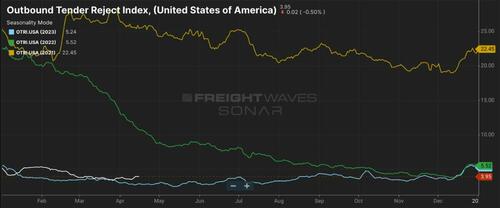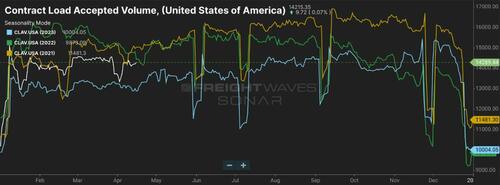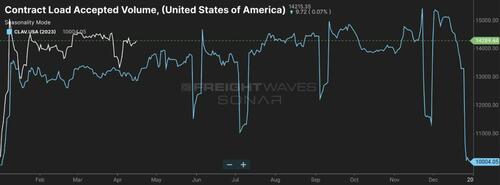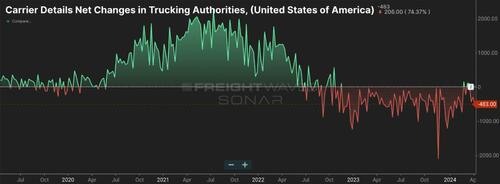The Great Freight Recession Has Now Lasted Longer Than The COVID Bull Market
By Greg Fuller, CEO of FreightWaves
On March 31, 2022, FreightWaves declared that a freight recession was imminent. More than two years later, the freight market remains in one of its deepest and longest recessions in history.
Our original conclusion was derived from signals from FreightWaves SONAR. Its high-frequency datasets, which track freight supply and demand in real-time, indicated an imminent collapse. When FreightWaves first published the article, many were not only skeptical of the conclusion, they derided FreightWaves for the call. Even after the recession took hold, few would have guessed that the freight downturn would be as deep or as long as it has been.
As we enter the third year of the Great Freight Recession, the trucking industry asks, “How much longer is the market going to remain in a recession?”
We believe that we are now at the bottom of the market.
SONAR’s Outbound Tender Rejection Index, or OTRI, measures the percentage of truckload transactions rejected by carriers. OTRI indicates that conditions are better than they were a year ago, albeit not by much.
Tender rejections are a highly reliable indicator of the balance of supply and demand. The higher the rejection rate, the more load options a carrier has. The lower the rate, the fewer load options a carrier has. While some will look at the absolute value of tender rejections, we also look at them in the context of where they have been.
Tender rejections are currently at 3.95%, up from the 2024 low of 3.39 on March 26 and up substantially from 2.88% a year ago.

We believe that tender rejections bottomed out in late March and have steadily increased throughout April, which is historically a soft month in freight. This indicates that the 2024 low is in the rearview mirror.
Contracted load accepted volumes, another SONAR index measuring contracted load demand, tell us that the market has grown since January 2023.
As of April 15, 2024, year-over-year contracted volumes are up 9%.
Contract accepted volumes are currently down 6% compared to April 2021, the peak of the COVID bull run.

While a gap certainly exists between peak volumes and current volumes, the gap is narrowing. In the past year, contracted load accepted volumes have increased by 9%.

The Atlanta Federal Reserve now forecasts that year-over-year GDP growth is up by 3%. In a normal growing economy, freight demand grows faster than economic growth. If the economy grows above 2% for the year, we expect that contracted load accepted volumes in 2025 will surpass the 2021 peaks.
Capacity will continue to decline
The growth in contracted load accepted volumes will occur at the same time that capacity continues to bleed out of the market.
Another of the many indices in the SONAR platform is the Carrier Details Net Revocation Data, which shows the increase or decline in the number of trucking companies in the market. In the chart below, anything above zero (green) shows an expansion in the number of trucking authorities, while anything below zero (red) shows a decline.

The index has been in negative territory since the fourth quarter of 2022. Capacity continues to leave the market, allowing the market to return to balance.
During the two years of the freight market’s COVID bull run, fleets built up substantial operating surpluses and were able to build strong balance sheets. This has enabled them to hang on for a long time.
For much of the Great Freight Recession, trucking fleets have been running many of their miles at losses. This has forced them to tap into the financial reserves they built up during the COVID bull run.
The Great Freight Recession has gone on longer than the COVID bull run, meaning that since the first days of the COVID lockdowns, truckers have operated primarily in recessionary territory. For those who remain in the market, their reserves are likely exhausted, as is their stamina.
However, for those who can continue, the tough times may be ending. The data suggests that a recovery in the balance of supply and demand will come as soon as fall 2024, but almost certainly by spring 2025.
Tyler Durden
Thu, 04/18/2024 – 17:00
via ZeroHedge News https://ift.tt/YfNAPQU Tyler Durden
